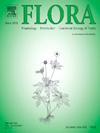热带山地灌木 Ribes ciliatum(Grossulariaceae)的植被性状、花生物学和互生相互作用
IF 1.8
4区 生物学
Q3 ECOLOGY
引用次数: 0
摘要
热带山地生态系统中的植物物种在短距离内经历着显著的环境变化。这些系统为评估植物性状与生物和非生物环境之间的地理差异提供了机会。我们研究了墨西哥中部两片原生针叶林中灌木 R. ciliatum 的植物性状和生殖性状。我们测量了冷杉林(海拔 3100 米)和哈特韦格松林(亚高山栖息地,海拔 3700 米)中的 R. ciliatum 种群的植株高度、分枝数量、叶片大小、花的产量、花的形态、花的寿命以及植物的繁殖成功率。我们还量化了这两个种群对授粉者的依赖程度、授粉者的访问率以及食草鸟类的果实消耗率。亚高山森林中的植物比冷杉林中的植物更矮小,叶片也更小。亚高山森林的花寿命缩短,但不同种群的花产量、花朵大小和果实重量保持相似。亚高山森林的坐果率和传粉昆虫的访问率更高;然而,不同地点的种子重量和果实消耗率并无差异。蜂鸟和熊蜂是 R. ciliatum 的主要传粉者,鸟类 Ptiliogonys cinereus 是两个地点最重要的果实消费者。坐果完全依赖于授粉者。亚高山森林中植株的减小与高山环境的一般模式相吻合。相比之下,生殖特征与授粉环境的关系更为密切。花的大小和形状没有变化,这与传粉昆虫群落组成的相似性是一致的。同时,与低海拔森林相比,亚高山森林的花期更短,坐果率更高,这与传粉昆虫的访问率较高有关。在这些高海拔山地森林中几乎没有其他花卉资源的季节,纤毛核果是传粉昆虫和食草动物的重要资源。本文章由计算机程序翻译,如有差异,请以英文原文为准。
Vegetative traits, floral biology, and mutualistic interactions in the tropical mountain shrub Ribes ciliatum (Grossulariaceae)
Plant species in tropical mountain ecosystems experience significant environmental variation across short spatial distances. These systems offer an opportunity to assess geographic variation in plant traits in relation to biotic and abiotic environments. We examined plant vegetative and reproductive traits in the shrub R. ciliatum across two native conifer forests in central Mexico. We measured plant height, number of branches, leaf size, flower production, floral morphology, floral longevity, and plant reproductive success in R. ciliatum populations found in fir forests (3100 m) and Hartweg's pine forests (subalpine habitat, 3700 m). We also quantified the level of pollinator dependence, pollinator visitation rates, and fruit consumption rates by frugivorous birds in both populations. Plants were shorter and had smaller leaves in the subalpine forest than in the fir forest. Floral longevity decreased in the subalpine forest, but flower production, flower size, and fruit weight remained similar across populations. Fruit set and pollinator visitation rates were higher in the subalpine forest; however, seed weight and fruit consumption rates did not differ between sites. Hummingbirds and bumblebees were the primary pollinators of R. ciliatum, and the bird Ptiliogonys cinereus was the most important fruit consumer at both sites. Fruit set was entirely dependent on pollinators. Reduced plant size in the subalpine forest coincides with a general pattern associated with high mountain environments. In contrast, reproductive characters had a closer relationship to the pollination environment. The absence of variation in flower size and shape was consistent with the similarity in the composition of the pollinator community. Meanwhile, compared to lower-elevation forests, the subalpine forest exhibited shorter-lived flowers and increased fruit set, associated with higher pollinator visitation rates. Ribes ciliatum is a key resource for pollinators and frugivores at a time of year when few other floral resources are available in these high-elevation mountain forests.
求助全文
通过发布文献求助,成功后即可免费获取论文全文。
去求助
来源期刊

Flora
生物-植物科学
CiteScore
3.30
自引率
10.50%
发文量
130
审稿时长
54 days
期刊介绍:
FLORA publishes original contributions and review articles on plant structure (morphology and anatomy), plant distribution (incl. phylogeography) and plant functional ecology (ecophysiology, population ecology and population genetics, organismic interactions, community ecology, ecosystem ecology). Manuscripts (both original and review articles) on a single topic can be compiled in Special Issues, for which suggestions are welcome.
FLORA, the scientific botanical journal with the longest uninterrupted publication sequence (since 1818), considers manuscripts in the above areas which appeal a broad scientific and international readership. Manuscripts focused on floristics and vegetation science will only be considered if they exceed the pure descriptive approach and have relevance for interpreting plant morphology, distribution or ecology. Manuscripts whose content is restricted to purely systematic and nomenclature matters, to geobotanical aspects of only local interest, to pure applications in agri-, horti- or silviculture and pharmacology, and experimental studies dealing exclusively with investigations at the cellular and subcellular level will not be accepted. Manuscripts dealing with comparative and evolutionary aspects of morphology, anatomy and development are welcome.
 求助内容:
求助内容: 应助结果提醒方式:
应助结果提醒方式:


